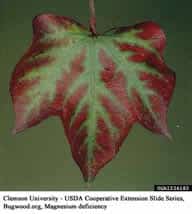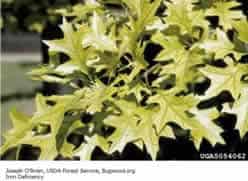 Description: Not all plant problems are caused by insects or diseases. Plants require nutrients to stay healthy and those aren’t always readily available. The first sign of nutrient deficient plants is usually seen on the leaves. They begin to discolor or become distorted. Because lots of other possibilities exist that discolor and distort leaves, it is sometimes difficult to pinpoint that a nutrient deficiency is the culprit.
Action: Try to eliminate other causes by checking for other common culprits. Are the leaves discolored due to insect activity? Too much fertilizer can cause leaf scorch. Have you treated the plants or trees with any chemicals recently? Make sure the ground isn’t too wet or too dry. Is your irrigation system working properly?
Description: Not all plant problems are caused by insects or diseases. Plants require nutrients to stay healthy and those aren’t always readily available. The first sign of nutrient deficient plants is usually seen on the leaves. They begin to discolor or become distorted. Because lots of other possibilities exist that discolor and distort leaves, it is sometimes difficult to pinpoint that a nutrient deficiency is the culprit.
Action: Try to eliminate other causes by checking for other common culprits. Are the leaves discolored due to insect activity? Too much fertilizer can cause leaf scorch. Have you treated the plants or trees with any chemicals recently? Make sure the ground isn’t too wet or too dry. Is your irrigation system working properly?
 The uptake of nutrients is dependent upon water. The other requirement is that the soil must be in the specific pH range that the plant needs to access the necessary nutrients. You may want to have your soil pH tested to make sure it is not too acidic or alkaline. Temperature extremes will also mimic nutrient deficiency.
Nutrients that are needed in relatively large supply to allow for healthy plants are called macronutrients. They are: nitrogen, potassium, phosphorus, calcium, sulfur and magnesium.
Micronutrients are also required, but in much smaller amounts. They are: boron, copper, iron, manganese, molybdenum and zinc.
Symptoms of macronutrient deficiencies are:
The uptake of nutrients is dependent upon water. The other requirement is that the soil must be in the specific pH range that the plant needs to access the necessary nutrients. You may want to have your soil pH tested to make sure it is not too acidic or alkaline. Temperature extremes will also mimic nutrient deficiency.
Nutrients that are needed in relatively large supply to allow for healthy plants are called macronutrients. They are: nitrogen, potassium, phosphorus, calcium, sulfur and magnesium.
Micronutrients are also required, but in much smaller amounts. They are: boron, copper, iron, manganese, molybdenum and zinc.
Symptoms of macronutrient deficiencies are:
- Nitrogen – older leaves, typically at the bottom of the plant, turn yellow
- Potassium – older leaves may look scorched around the edge and yellowing between leaf veins may occur
- Phosphorus – small leaves may take on a reddish-purple tint; leaf tips can look burnt and older leaves turn almost black; fruit and seed production is reduced
- Calcium – new leaves are distorted or hook shaped; the growing tip may die
- Sulfur – new growth turns pale yellow, older growth stays green; stunts growth
- Magnesium – slow growth and leaves turn pale yellow, sometimes only outer edges; new growth may be yellow with dark spots










